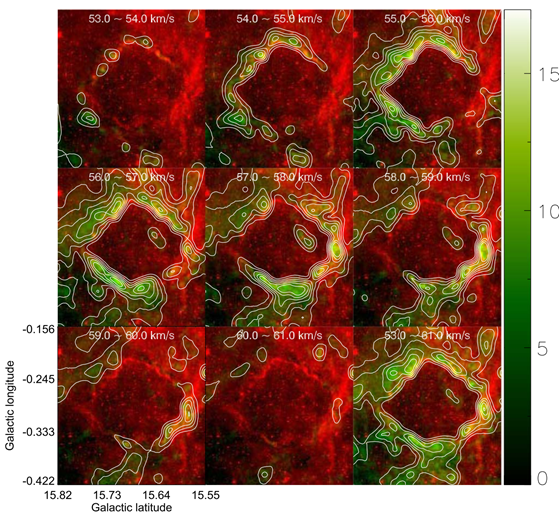The infrared (IR) dust bubble is a shell structure formed by the interaction of the expanding H II region with the surrounding interstellar medium (ISM). It provides us with a good sample to study whether the expanding H II regions could trigger the formation of a new generation of stars. There have been many studies on individual bubble (Yuan et al. 2014; Dale et al. 2015; Liu et al. 2015; Ranjan Das et al. 2016; Duronea et al. 2017) or large sample of bubbles (Kendrew et al. 2012; Thompson et al. 2012) in recent years. However, it is still not clear how triggered star formation takes place or how much it contributes to the total star formation.
Considering that expanding bubbles interact with surrounding materials and trigger star formation, it is reasonable to expect that bubbles of larger size will have much more time to sweep around the surrounding materials, and thus have more chances to trigger star formation and then show more evidence of triggered star formation (Yuan et al. 2014). As a pilot study, we first investigate G15.684-0.29 as one example of the largest bubbles in our 226 sample.
G15.684-0.29, which has a diameter of 31.4 pc, it is one of the largest bubbles in the Galaxy (Fig.1). If G15.684-0.29 evolves in a turbulent medium, its dynamical age, ~4 Myr, is much greater than the shell fragmentation time, 0.82–1.74 Myr. It will have enough time to collect materials and form a new generation of stars. The ring-liked compressed shell is well traced by both dust and CO emission, dense massive clumps traced by dust and CO emission regularly space along the shell, and are forming new stars/clusters actively. 31 dust clumps and 18 CO clumps lie in the shell of the bubble G15.684-0.29, most of them satisfy the criteria for massive star formation. We found 49 YSOs around the bubble, including 9 Class I YSOs, 28 Class II YSOs, and 12 TDs. For Class I YSOs, one lies inside the bubble, two lie outside the bubble, and 6 lie in the shell. For Class II YSOs, 15 lie inside the bubble, 6 lie outside the bubble, and 7 lie in the shell. For TDs, three lie inside the bubble, seven lie outside the bubble, and two lie in the shell. It is clear that younger YSOs tend to be located on the compressed bubble shell, or closer to it. All above results evidence that triggered star formation is taking place around the bubble, the collect and collapse model may play a major role here. The paper has been published in ApJ (Zhou et al. 2020, ApJ, 897,74).

Fig.1 Here we display the channel maps of 12CO(3–2) from 53 to 61 km sˉ1 (the contour levels are 3, 5, 7, 9, 11, and 13 times σrms, the σrms equal to 0.74 K km sˉ1) and the total integrated intensity map (the levels increase from 20% to 90% of the peak integrated intensity by a step of 10%) in the green scale and white contour on the 8 μm emission (in red).
Article Link:https://iopscience.iop.org/article/10.3847/1538-4357/ab94c0/pdf
Contact: ZHOU Jianjun
Xinjiang Astronomical Observatory, Chinese Academy of Sciences
Email: zhoujj@xao.ac.cn